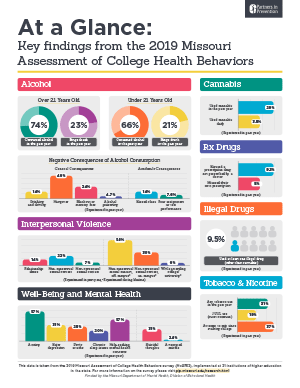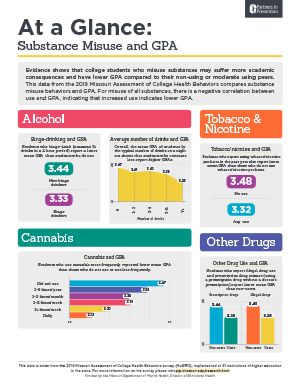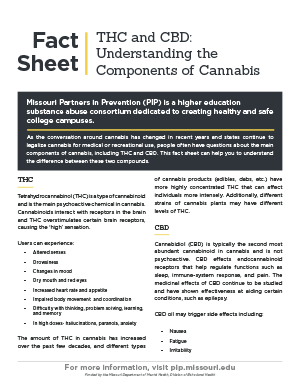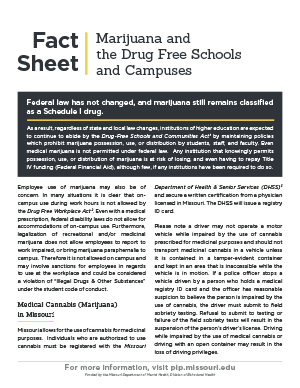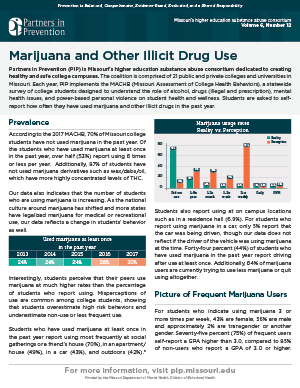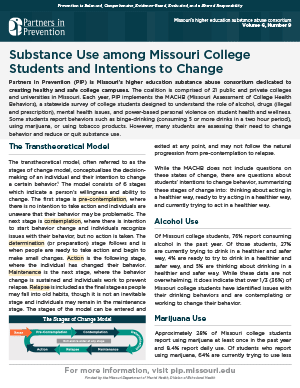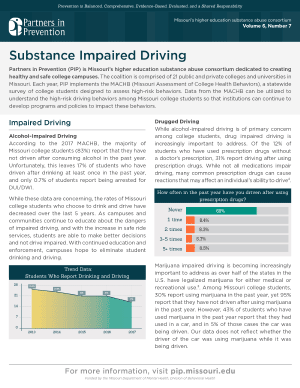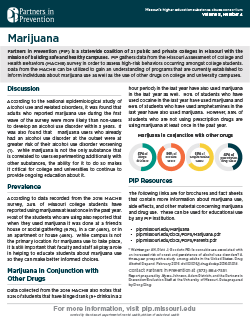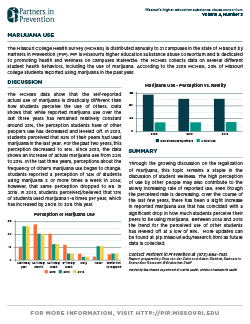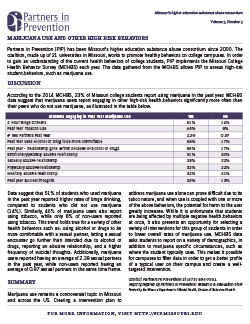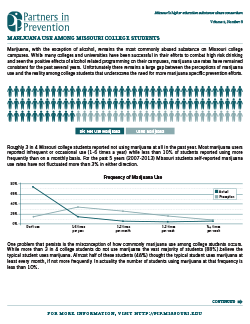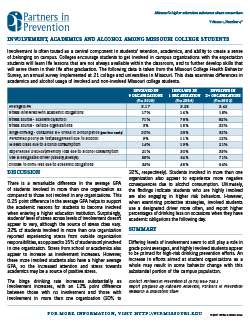
Cannabis

Cannabis is the most commonly used illicit drug by college students.
An analysis of national survey data indicates that students attending college are at a significantly higher risk of beginning to use cannabis than those not enrolled in college, underscoring the need for improved prevention efforts. Studies have also established an association between cannabis use and poor academic performance in college. There are also negative short and long-term health effects of using cannabis, and long-term use can lead to addiction and/or dependence.
Scope
National Data
The rate of current use of illicit drugs among young adults aged 18 to 25 in 2013 (21.5%) was similar to the rates in 2009 to 2012 (ranging from 21.3% to 21.6%), which was consistent with the steady rate of current cannabis use in this age group during this time (19.1% in 2013 and ranging from 18.2% to 19.0% in 2009 to 2012).
Daily cannabis use among college-aged young adults has been climbing in recent years. In fact, 11.8% of non-college youth (those 1 to 4 years beyond high school) were daily users in 2015—the highest since 1980.
Cannabis use had the largest number of persons with dependence or misuse among illicit drugs in 2013 with 4.2 million individuals – approximately 9% of users overall become addicted to marijuana.
An advisory statement from the U.S. Surgeon General notes the dangers of cannabis use on brain development
Missouri Data
The 2018 Missouri Assessment of College Health Behaviors (MACHB) indicates that statewide in the past year:
| 69% | 15% | 5% | 3% | 3% | 4% | 2% |
| Did not use | 1-6x/year | 1-2x/month | 1-2x/week | 3x/week+ | Daily | PNR |
Students report using cannabis in the following places:
| 72% | 50% | 46% | 42% | 35% |
| Social event off campus | Apartment/house | In a car | Outdoors | Party |
Of students who used cannabis at least once in the past year, 11% report using a cannabis derivative such as wax, dabs, or oils and 17% report using a cannabis edible
It is never safe to use cannabis and drive a vehicle, and of students who had used cannabis at least once in the past year, 5.1% report driving after using cannabis.
MACHB data indicates that 34% of Missouri college students that use cannabis are thinking about quitting less or using, ready to use less or quit, or are currently trying to use less or quit.Population Considerations
Annual cannabis use is higher among college males than females (39% versus 32%).
Among full-time college students aged 18 to 22 in 2013, the rate of current illicit drug use was:
| 25.1% | 21.5% | 19.7% | 9.7% |
| White | Hispanic | African American | Asian |
Data Briefs and Fact Sheets
Click on a brief below for more information.
At a Glance
Fact Sheets
Volume 8
Volume 7
Volume 6
Volume 5
Volume 4
Volume 3
Volume 2
Volume 1
Best Practices
Quick Links
Risk and Protective Factors | Evidence-based Practices and Interventions | Policies | Strategies | Harm Reduction | Social NormsRisk and Protective Factors
Risk Factors
- Lack of supervision by parent/guardian
- Access
- Associating with peers who use drugs
- Club culture or party culture
- Preexisting mental health problems
- Norms that permit or encourage cannabis use
- Adolescent risk-seeking behavior
- Lack of organized activities
Protective Factors
- High self-esteem and sense of identity
- Development of healthy coping skills
- Norms discouraging cannabis use
- Feelings of connectedness
- Campus policy (and enforcement)
- Effective prevention programming in place
Evidence-based Practices and Interventions
Screening, Brief Intervention, and Referral to Treatment (SBIRT)
SBIRT is a process in which the individual is screened, brief motivational interviewing occurs, and the individual is referred to appropriate resources.
Brief Motivational Interviewing (BMI)
Brief Motivational Interviewing (BMI) is a strategy in which a trained professional conducts a brief counseling session, exploring behaviors and resolving feelings of ambivalence towards problem behaviors. An example of this is modifying BASICS for cannabis use (sometimes referred to as CASICS).
Cognitive-Behavioral Therapy (From the National Institute on Drug Abuse)
Cognitive-Behavioral Therapy (CBT) was developed as a method to prevent relapse when treating problem drinking, and can be adapted for cannabis use. Cognitive-behavioral strategies are based on the theory that in the development of maladaptive behavioral patterns like substance misuse, learning processes play a critical role. Individuals in CBT learn to identify and correct problematic behaviors by applying a range of different skills that can be used to stop drug misuse and to address a range of other problems that often co-occur with it.
A central element of CBT is anticipating likely problems and enhancing patients’ self-control by helping them develop effective coping strategies. Specific techniques include exploring the positive and negative consequences of continued drug use, self-monitoring to recognize cravings early and identify situations that might put one at risk for use, and developing strategies for coping with cravings and avoiding those high-risk situations.
- The County of San Diego has a great literature review on best practices for marijuana from their department of Health and Human Services.
- SAMHSA also has a good guide from 2014 on strategies and interventions to prevent youth marijuana use and covers interventions on an individual level, a relationship level, a community level, and a society level.
- The Minnesota Department of Health and Human Services has an extensive bibliography from 2015 of best practices for marijuana use prevention.
- The Campus Cannabis Prevention Toolkit
- Michigan Collegiate Cannabis Prevention Toolkit from the Michigan Higher Education Network
Policies
Policy change has been shown to aid in the reduction of cannabis use. Some examples of policy change include strict no-use cannabis policy and policies about impairment on campus.
While state laws across the country are changing, cannabis is still an illegal substance in the state of Missouri. While some counties or cities have chosen to decriminalize cannabis for small amounts, all Missouri colleges and universities are covered under the federal Safe and Drug-Free Schools and Communities Act that prevents the use of illegal drugs on campus.
Individual campuses also have their own policies and procedures for handling possession of illegal drugs, paraphernalia, and other drug violations. Check with your campus law enforcement and/or conduct office for information on specific policies on your campus.
Environmental Strategies
Environmental strategies, alongside policy change, strengthen more accurate peer perceptions about acceptability of use and risks. Some examples of environmental strategies include limiting retailer availability, restricting locations where cannabis can be bought and used, and minimizing youth exposure to cannabis advertising.
Harm Reduction
Harm reduction methods can aid in reducing harmful behaviors of those who have decided to use cannabis already and do not wish to cease use. These strategies aim to minimize harm from use.
Social Norms
Social norms campaigns have shown to be effective in changing attitudes and perceptions of individuals related to the safety, prevalence, and risks of cannabis use.
*Adapted from the Michigan Collegiate Cannabis Prevention Toolkit
National Resources
- National Institute on Drug Abuse (NIDA): drugabuse.gov
- Substance Abuse and Mental Health Services Administration (SAMHSA): samhsa.gov
- Marijuana Anonymous: marijuana-anonymous.org
- Get Smart About Drugs: getsmartaboutdrugs.gov
- Recovery Hotline: 1 (888) 497-6596
- Recovery Village Hotline: 1 (844) 297-8112
- Practitioners Toolbox: campusdrugprevention.gov/content/practitioners-toolbox
- Prevention Action Alliance - Marijuana Fact Sheets: preventionactionalliance.org/learn/about-marijuana/marijuana-fact-sheets
PIP Resources
Click on a brief below for more information.
Fact Sheets
Research
Relevant Research Articles
- Marijuana use trajectories and academic outcomes among college students
- Prevalence of marijuana use at college entry and risk factors for initiation during freshman year
- Marijuana use trajectories during college predict health outcomes nine years post-matriculation
- Neurocognition in college-aged daily marijuana users
- Indicated prevention for college student marijuana use: A randomized controlled trial
- College students at increased risk for smoking marijuana
- Marijuana use- College-age and young adults
- Monitoring the Future. National Survey Results on Drug Use. 2013 Overview- Key Findings on Adolescent Drug Use
